José María Morelos
José María Teclo Morelos Pérez y Pavón (Spanish: [xoˈse maˈɾi.a ˈteklo moˈɾelos ˈpeɾes i paˈβon] (![]()
José María Morelos | |
|---|---|
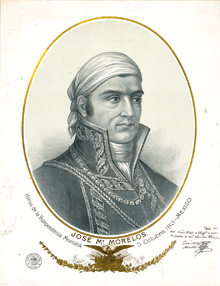 Engraving of Morelos, signed three weeks after the Congreso de Anáhuac in Chilpancingo. | |
| President of the Supreme Mexican Government | |
| In office October 24, 1814 – November 5, 1815 | |
| Preceded by | Post established |
| Succeeded by | Ignacio Alas |
| Chief of the Congress of Anáhuac | |
| In office September 15, 1813 – October 24, 1814 | |
| Preceded by | Post established |
| Succeeded by | Himself as president under the Constitution of Apatzingan |
| Member of the Council of Zitacuaro | |
| In office August 19, 1811 – September 15, 1813 | |
| Personal details | |
| Born | September 30, 1765 Valladolid, Michoacán, New Spain |
| Died | December 22, 1815 (aged 50) San Cristóbal Ecatepec, State of México |
| Resting place | Angel of Independence, Mexico City |
| Children | Juan Nepomuceno Almonte |
| Alma mater | Universidad Michoacana de San Nicolás de Hidalgo |
| Profession | Arriero, Priest, Military leader, Politician |
| Signature |  |
| Military service | |
| Allegiance | Mexico |
| Branch/service | |
| Years of service | 1810–1815 |
| Rank | Generalissimo, Captain General, Colonel |
| Battles/wars | Mexican War of Independence |
After a series of defeats he was captured by the Spanish royalist military, tried by the Inquisition, defrocked as a cleric, and executed by civil authorities for treason in 1815. Morelos is a national hero in Mexico and is considered a very successful military leader despite the fact that he never took a military career and was instead a priest.
Early life
Morelos was born in Valladolid, since renamed "Morelia" in his honor. Although he is often presented as "mixed-race" by indigenist historians, Morelos was considered a Spaniard rather than a Mestizo under the social structure of the time and was registered as such in his local parish upon baptism. [2]
His father was José Manuel Morelos y Robles, a carpenter originally from Zindurio, village a few kilometers west of Valladolid. His mother was Juana María Guadalupe Pérez Pavón, originally from San Juan Bautista de Apaseo, also near Valladolid. Valladolid was the seat of a bishop and of the government of the colonial Intendency of Valladolid. It was known as the "Garden of the Viceroyalty of New Spain" because of its prosperity.
Through his paternal line, Morelos was related to Miguel Hidalgo y Costilla.[3] Both insurgents shared a common ancestor, Diego Ruiz de Cortés, who was a descendant of the conquistador Hernán Cortés.[3] Hidalgo was the descendant of Ruiz de Cortés through his mother, Ana María Gallaga.[3]
Morelos worked as a muleteer (arriero) in the area where he fought in the insurgency, on the ground experience of the terrain that would be valuable.[2] He is also said to have worked on a rancho rented (rather than owned) by his uncle for nearly ten years.[4]
Morelos had ambitions for something more than working with his hands, and assiduously studied; his maternal grandfather was a school teacher.[5] In 1789, he enrolled in the Colegio de San Nicolás Obispo in Valladolid, where Father Miguel Hidalgo y Costilla was rector.[5] When he was ordained a priest, he, as with many others without connections, had no benefice to guarantee any income as a priest.[5] However, since he was a secular cleric and therefore took no vow of poverty, he could freely pursue business activities to make a living.[5]
As a priest, he could not marry, but he did form a relationship with at least one woman, Brígida Almonte. He is known to have fathered three children, two sons and a daughter. His first born was Juan Nepomuceno Almonte, who played a significant role himself in Mexican history.[6] Lucas Alamán, a fierce nineteenth-century opponent of the insurgency and after independence a conservative politician and historian, asserted that Morelos "fathered various children with anonymous women of the people."[7] This charge of promiscuity might simply be a slur without foundation on the insurgent-priest. At Morelos's trial, the Inquisition accused him of sending his son to the United States. He testified at his trial that "while he had not been completely pristine for a priest, he had not acted in a scandalous manner" and that he had sent his son away for education and for his safety, thereby acknowledging his paternity.[8]
Insurrection against Spain

The former rector of the Colegio de San Nicolás Obispo (where Morelos attended seminary), Father Miguel Hidalgo y Costilla was planning with others for the independence of New Spain from the Spanish empire. About 6:00 a.m. on September 16, 1810, Hidalgo then the parish priest of Dolores, Guanajuato (since renamed Dolores Hidalgo in his honor), hastily ordered the church bells to be rung, and gathered his congregation. Flanked by Ignacio Allende and Juan Aldama, Hidalgo addressed the people in front of his church, urging them to take up arms, with the Cry of Independence (El Grito de Dolores, now celebrated every year on September 15 at 11:00 p.m.) that called for armed revolt after the Spanish colonial authorities had discovered the Conspiracy of Querétaro, a clandestine movement seeking Mexican independence. Like Allende and Aldama, Josefa Ortiz de Domínguez, popularly known as La Corregidora, was one of the famous initial supporters of the revolt. Miguel Hidalgo and his followers rose in open rebellion against the Spanish colonial authorities launching what became the Mexican War of Independence.
With the imperial government taken by surprise, operatives took important cities of the Bajío region without an organized response. The insurgency proclaimed Hidalgo captain general of Mexico in Celaya on September 21. Hidalgo y Costilla advanced as far as Guanajuato; and on September 28, the rebels captured the Alhóndiga de Granaditas in battle, killing at least 500 Spaniards who had taken shelter there. Among the dead was the crown's highest official in Guanajuato, Intendant Juan Antonio Riaño, an old friend of Hidalgo y Costilla.

The bishop of Michoacán, Manuel Abad y Queipo, excommunicated the insurgents. Hidalgo y Costilla and his army marched on to Valladolid, where the locals feared that the slaughter of Guanajuato would be repeated, prompting many people to abandon the region, particularly elites. Valladolid was taken peacefully on October 17, 1810.
In Tacámbaro Hidalgo y Costilla was proclaimed general, and Allende captain general. Hidalgo ordered a rest for his troops in Indaparapeo, where a few minutes before their departure, Morelos, who had read about his excommunication and his triumphs, found him.
Morelos had heard of the revolt in October 1810 and determined to join it.[9] Hidalgo asked his former student to recruit troops in the south of the colony and capture the port of Acapulco, the west coast port for the Pacific trade to the Philippines, also a Spanish colony.[10] Unlike Hidalgo, who was a poor tactician leading a huge and undisciplined following, Morelos quickly demonstrated military skills, gathering and training a small core of fighters. He sought allies in the region, and obtained cannon and other war materiel.[10]
Morelos's hopes for the rebellion called for the creation of a republican government that “all Mexican people would participate, the abolition of slavery, and the elimination of divisions between races and ethnicities.”[11] Morelos saw the suffering of the poor at the ends of the Church and the elites, and believed that these things must be changed in order to achieve the full participation of the people in the new government. Morelos also called for the end of the Church's special privileges and the redistribution of large estates among the people. These principles demonstrated the rebellion's desire to achieve both independence and justice for the poor.
Campaigns

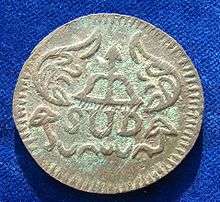
Morelos soon showed himself to be a talented strategist, and became one of the greatest revolutionary military commanders of the war. In his first nine months, he won 22 victories, annihilating the armies of three Spanish royalist leaders and dominating almost all of what is now the state of Guerrero. In December, he captured Acapulco for the first time, except for the Fort of San Diego. Spanish reinforcements forced him to raise the siege in January. By quick marches, he was able to capture most of the Spanish possessions on the Pacific coast of what are now Michoacán and Guerrero. On May 24, 1811, he occupied Chilpancingo and on May 26 he took Tixtla.
In his second campaign, Morelos divided his army into three groups. The most important engagement of this campaign was at Cuautla. On Christmas Eve 1811 the townspeople welcomed Morelos to the town. The next year his forces were besieged by the Spanish army under general Félix María Calleja del Rey. On May 2, 1812, after 58 days, Morelos broke through the siege, and started his third campaign.
Major victories on this third campaign were at Citlalli on June 8, 1812, Tehuacán on August 10, 1812, Orizaba, Oaxaca and Acapulco. Morelos arrived at Orizaba with 10,000 soldiers on October 28, 1812. The city was defended by 600 Spanish soldiers. Negotiation led to a surrender without bloodshed. He entered Oaxaca in triumph on November 25, 1812. Acapulco fell on April 12, 1813, forcing the Spanish army to take refuge in Fort of San Diego
Congress of Chilpancingo


In 1813, Morelos called the National Constituent Congress of Chilpancingo, composed of representatives of the provinces under his control, to consider a political and social program which he outlined in a document entitled "Sentimientos de la Nación" (Sentiments of the Nation). The Congress called itself the Congress of Anáhuac, referring poetically to the ancient Aztecs.
On September 31, 1813, the Congress, with Morelos present, endorsed the "Sentiments of the Nation". This document declared Mexican independence from Spain, established the Roman Catholic religion and created the legislative, executive and judicial branches of government. It declared respect for property and confiscated the productions of the Spanish colonial government. It abolished slavery and racial social distinctions in favor of the title "American" for all native-born individuals. Torture, monopolies and the system of tributes were also abolished. Morelos was offered the title "Generalissimo" with the style of address "Your Highness", but he refused these and asked to be called "Siervo de la Nación" (Servant of the Nation). On November 6, 1813, the Congress declared independence.
After several military defeats, the Congress organized a meeting in Apatzingán, and on October 22 promulgated the "Decreto Constitucional para la Libertad de la América Mexicana" (Constitution of Apatzingán). This established a weak executive and a powerful legislature, the opposite of what Morelos had called for. He nevertheless conceded that it was the best he could hope for under the circumstances.
Capture and execution

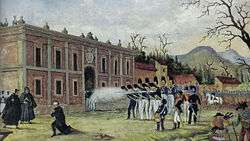
Shortly thereafter, Morelos began his fourth military campaign, a series of disasters beginning at Valladolid in late 1813. While escorting the new insurgent Congress in November 1815, he was defeated in Tezmalaca by royalist forces. Morelos and his guard were surrounded; rather than have all taken prisoner, Morelos told his men to each save himself. This left Morelos to be captured alone.[12] As a Catholic priest, the church had jurisdiction for his imprisonment and trial; he was jailed in the Inquisition building in Mexico City.[13] Although Morelos was a huge prize for the royal government, the viceroy decided not to make a public spectacle of his journey of incarceration, but rather slipped him into the capital before dawn.[13]
The royal government had experience with the trial and execution of Father Miguel Hidalgo y Costilla, which was done far from the capital and in rushed fashion; but Morelos's trial was conducted in the capital with the highest officials presiding, with the outcome of a guilty verdict and execution by civil officials. Inquisition officials drew up 23 charges against Morelos, and following proper procedure, Morelos had a defense attorney, one Lic. José Quiles.[14] He was charged with treason, disloyalty to the crown, and transgressions in his personal life, namely, sending his natural sons to the United States for education.[15]
He was tried and sentenced to death for treason. Morelos was executed by firing squad on December 22, 1815, in San Cristóbal Ecatepec, north of Mexico City in order that his execution not provoke a dangerous public reaction. He was later judged to be reconciled to the church, lifting his excommunication, as he was seen praying on his way to his execution.[16] After his death, his lieutenant, Vicente Guerrero, continued the war for independence.
Legacy
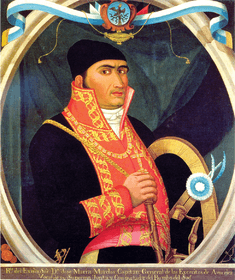
Morelos is considered a national hero of Mexico; the state of Morelos and city of Morelia are named after him. Morelos has been portrayed on the 50-peso note since 1997, and on 1-peso coins during the 1940s, 1970s and 1980s. The Estadio Morelos in Morelia, Puerto Morelos in the state of Quintana Roo, the Morelos Station on the Mexico City Metro, Ecatepec the city in Mexico State where he was executed and the Morelos Satellite from the Communications company Satmex are also named after him. His remains were transferred to the Monument to Independence El Ángel in Mexico City, along with those of other heroes of the insurgency. The Presidential aircraft Boeing 787 TP-01 was named José María Morelos y Pavón.
- The Angel of Independence in Mexico City, where the remains of Morelos are entombed in the mausoleum at its base
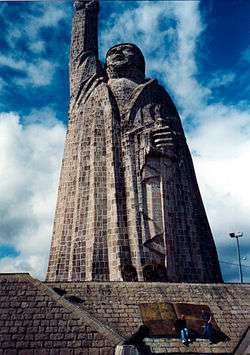
- Monument to José María Morelos y Pavón in Lincoln Park, Los Angeles, California, gift of Mexico President José López Portillo
 Citadel Square; José María Morelos
Citadel Square; José María Morelos
References
- Dates and other biographical information in this article are drawn from Appleton's Cyclopedia of American Biography 1887-89.
- Guedea, "José María Morelos", p. 948
- Castro, Jesús. "Con sangre sacerdotal heredó Hidalgo la sotana". vanguardia.com.mx. Retrieved June 15, 2012.
- Krauze, Enrique Mexico: Biography of Power. New York: HarperCollins 1997, p. 103.
- Krauze, Mexico: Biography of Power, p. 105.
- Guedea, Virginia. "José María Morelos" in Encyclopedia of Mexico, Chicago: Fitzroy Dearborn, 1997, p. 948.
- Alamán quoted in Krauze, Mexico: Biography of Power, p. 106
- Archer, Christon I. "Death's Patriots", p. 78.
- Guedea, "José María Morelos" in Encyclopedia of Mexico, Chicago: Fitzroy Dearborn 1997, 948.
- Guedea, "José María Morelos", p. 948.
- Meade, Teresa A. 2010. A History of Modern Latin America: 1800 to the present. Chichester, West Sussex, U.K.: Wiley-Blackwell, p. 72.
- Christon I. Archer, "Death's Patriots--Celebration, Denunciation, and Memories of Mexico's Independence Heroes: Miguel de Hidalgo, José María Morelos, and Agustín de Iturbide" in Death, Dismemberment, and Memory in Latin America, Lyman L. Johnson, ed. Albuquerque: University of New Mexico Press 2004, p. 76.
- Archer, "Death's Patriots", p. 76.
- Archer, "Death's Patriots", p. 78.
- Archer, "Death's Patriots" p. 78.
- Gustavo Watson Marron, director of the historical archive of the archdiocese, cited in El Universal, August 31, 2009.
Further reading
| Spanish Wikisource has original text related to this article: |
- Archer, Christon I. "Death's Patriots--Celebration, Denunciation, and Memories of Mexico's Independence Heroes: Miguel de Hidalgo, José María Morelos, and Agustín de Iturbide" in Death, Dismemberment, and Memory in Latin America, Lyman L. Johnson, ed. Albuquerque: University of New Mexico Press 2004 pp. 63–104.
- Guedea, Virginia. "José María Morelos" in Encyclopedia of Mexico, Chicago: Fitzroy Dearborn, 1997, pp. 948–950.
- Hamnett, Brian R. Roots of Insurgency: Mexican Regions, 1750-1824. Cambridge: Cambridge University Press 1986.
- Lemoine Villacaña, Ernesto. Morelos, su vida revolucionaria a través de sus escritos y de otros testimonios de la época. Mexico City: Universidad Nacional Autónoma de México 1965.
- Timmons, Wilbert H. Morelos: Priest, Soldier, Statesman of Mexico, revised edition. El Paso: Texas Western College Press 1970.
External links
![]()
- Wallace L. McKeehan, "José María Morelos Man of God, Warrior & Patriot"
- "Mexico Builds Her Own Statue Of Liberty" Popular Science Monthly, February 1936